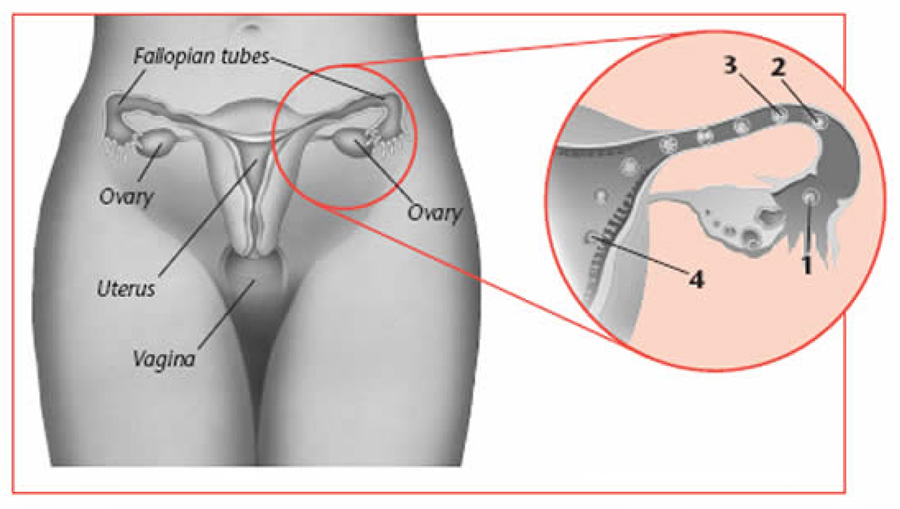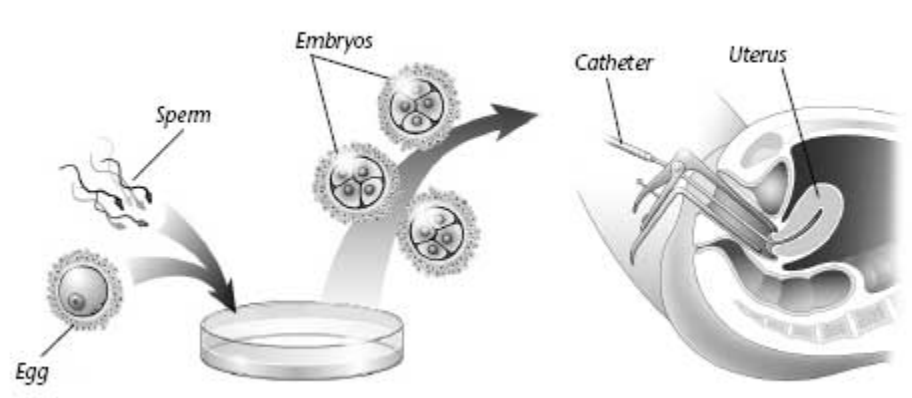About 10% of couples in the United States are infertile. Infertility is a condition in which a woman has not been able to get pregnant after 6–12 months of having sex without using birth control. Before being treated for infertility, you and your partner must be evaluated by a doctor. This may help pinpoint the cause or causes of infertility. The type of treatment you receive depends on what may be causing the infertility. This page explains:
- Causes of infertility
- Treatment options
- Other choices
Infertility can be treated. Lifestyle changes, medication, surgery, or assisted reproductive technologies may help.
Infertility
For healthy, young couples having sex, the odds are about 20% that a woman will become pregnant during any one menstrual cycle. This figure starts to decrease in a woman’s early 30s and decreases even more after age 37 years. A man’s fertility also declines with age, but not as early. Many women and couples today choose to delay parenthood. Because they are older, they may have problems conceiving.
If you are not able to get pregnant after 12 months of unprotected sex, your doctor can evaluate you and your partner. If you are older than age 35 years or have certain medical problems, tests should be started earlier.
Causes
Infertility may be caused by a problem with the woman, the man, the couple, or their lifestyle. Sexually transmitted diseases (STDs) also may reduce a couple’s fertility. Infertility may be caused by more than one factor. Some of the most common causes include:
- Problems with ovulation
- Blocked fallopian tubes
- Health or quality of sperm
Sometimes a cause cannot be found.
Treatments
To treat infertility, your doctor may suggest medication, surgery, or assisted reproductive technologies (ART). He or she also may refer you to a specialist in treating infertility. In some cases, different treatments may be used together to improve results. Whether the problem lies with one or both partners, a number of treatments could be considered.
You should know the expected success rates of the treatment you use and how success is defined. Some clinics define success rates for ART based on the number of live births. Others define success based on the number of pregnancies (even if they do not result in live births). The Centers for Disease Control and Prevention (CDC) list the success rates for ART for most clinics in the United States on its web site (www.cdc.gov/reproductivehealth/index.htm). You should discuss the success rates of your options with your doctor.
If the reason for infertility is linked to lifestyle, you can take steps that will help. For instance, your doctor may suggest you change when or how often you have sex. You may need to lose or gain weight, increase or decrease exercise, or stop smoking.
Medical treatment may be needed to help you become pregnant. If so, you should be aware of what is involved. Some treatments require much expense and effort from both partners. Many increase the chance of a multiple pregnancy. You may want to check your health insurance to see if it covers the treatments.

Each month during ovulation an egg is released (1) and moves into one of the fallopian tubes (2). If a woman has sex around this time, an egg may meet a sperm in the tube and the two may join (3). This is called fertilization. The fertilized egg then moves through the fallopian tube into the uterus and becomes attached there to grow during pregnancy (4).
Ovulation Induction
If the woman does not ovulate (release an egg from an ovary), there are medications she can take to cause ovulation. Even if a woman is ovulating, she may need to release more eggs in order to get pregnant.
The medication used most often to cause ovulation is clomiphene citrate. It may be used for several cycles. The dosage may be increased over time if ovulation does not occur.
Ovulation or pregnancy may not occur after treatment with clomiphene citrate. If not, medications called gonadotropins may be given by injection. These drugs stimulate the eggs to develop. Blood tests and ultrasound are used to track the development of eggs. If too many eggs develop, your doctor may stop that cycle.
Most women who take drugs to cause ovulation start to ovulate regularly. If there are no other problems, more than half of such women get pregnant within 6 treatment cycles. If a woman does not start ovulating, other tests may be needed.
A multiple pregnancy may occur with the use of these drugs. That is when more than one fetus grows in the uterus. The risk is higher with gonadotropins than with clomiphene citrate. If this happens, your doctor will explain your options. One option is fetal reduction, in which one or more fetuses are terminated to give the remaining fetuses a better chance to grow into a healthy baby.
Rarely, a condition called ovarian hyperstimulation syndrome may occur. If you are at risk for this condition, treatment may be altered, and you will be closely monitored.
Surgery
If the fallopian tubes are blocked, surgery may be done to open or remove them. Surgery also may be done to:
- Remove growths such as polyps or fibroids
- Remove scarring from a previous surgery, infection, or endometriosis
- Treat endometriosis (if found)
If the problem is with the man’s sperm, surgery can sometimes fix it. The success of surgery depends on the type and extent of the problem.
Artificial Insemination
With insemination, sperm is placed in a woman’s uterus by means other than sex. In most cases, the sperm are treated in a lab. The goal is to decrease the risk of infections and increase the chance that an egg will be fertilized. Around the time the woman ovulates, the doctor places the sperm into the uterus.
The woman’s partner or a donor may provide the sperm for insemination. Sperm from a donor is frozen, and the donor is checked to make sure he is free of certain medical problems. These problems include some genetic disorders and STDs, including human immunodeficiency virus (HIV). Talk with your doctor about the specific tests that are done at the lab where you are treated.
Assisted Reproductive Technologies
Assisted reproductive technologies (ART) are ways to process eggs and sperm to help an infertile couple conceive a child. They are done in a lab. Sometimes, ART treatments use donor eggs or sperm. The sperm also may come from your partner through masturbation or the use of a special condom during intercourse. In some cases, sperm may be obtained surgically by sperm aspiration or testicular biopsy. Following are some of the ART treatments that are available to couples trying to conceive.
In Vitro Fertilization
In vitro fertilization (IVF) uses sperm to fertilize eggs from the woman in a lab. The fertilized egg then is placed in the woman’s uterus to grow.

For IVF, eggs are removed from an ovary just before a woman ovulates. Usually, she first takes medication to make more than one egg mature. Eggs are removed with a needle that is inserted through the vagina and into the ovary. Ultrasound is used to guide the needle. The eggs then are withdrawn through the needle. Pain relief or a sedative may be given.
There are two ways to combine the eggs and sperm. Most often, the eggs are combined with healthy sperm and monitored in the lab to see if they become fertilized. Sometimes, a single sperm may be injected into each egg. This is called intracytoplasmic sperm injection (ICSI). This may be a good option if there is a problem with the man’s sperm because only a few healthy sperm are needed.
A few days later, one or more fertilized eggs (embryos) are placed in the woman’s uterus through her vagina. This is called embryo transfer. Transferring fewer embryos reduces the risk of a multiple pregnancy. Any extra embryos that are not used may be frozen and stored for later use.
The success rate of IVF depends on the woman’s age and the reason for the infertility. As with ovulation drugs and other procedures, side effects of IVF can include multiple pregnancy and ovarian hyperstimulation syndrome. Fetal reduction is an option in multiple pregnancies.
Intrafallopian Transfers
Rarely, two other treatments may be used for women who have certain conditions of the cervix. In both, eggs are removed using a needle.
One is called gamete intrafallopian transfer (GIFT). With this procedure, eggs are fertilized in the woman’s body. The eggs and sperm are placed in the fallopian tube using laparoscopy and fertilization may result. Zygote intrafallopian transfer (ZIFT) also may be an option. With ZIFT, the eggs are fertilized in a lab. One or more embryos then are placed in a tube using laparoscopy and pregnancy may result.
Both treatments are more costly than IVF because they require surgery. Possible side effects are the same as for IVF and ovulation medications. As with any surgery, though, there are additional risks, such as infection or problems related to the anesthesia. Before having either of these procedures, talk to your doctor about the risks.
Other Choices
You and your partner should give careful thought to all your options. You may want to think about other choices, including adoption and life without children. Discuss your feelings with your partner. Sometimes counseling can help to sort out these feelings. Support groups made up of other infertile couples also may help.
Finally…
Infertility often can be treated. Lifestyle changes, medication, surgery, or ART may help. Evaluation and treatment takes a big commitment from both partners. After your evaluation, talk with your doctor about treatment options for you and your partner.
Glossary
Assisted Reproductive Technologies: Procedures that involve processing human eggs and sperm or both to help an infertile couple conceive a child.
Endometriosis: A condition in which tissue similar to that normally lining the uterus is found outside of the uterus, usually on the ovaries, fallopian tubes, and other pelvic structures.
Human Immunodeficiency Virus (HIV): A virus that attacks certain cells of the body’s immune system and causes acquired immunodeficiency syndrome (AIDS).
Laparoscopy: A surgical procedure in which a slender, light-transmitting instrument, the laparoscope, is used to view the pelvic organs or perform surgery.
Masturbation: Self-stimulation of the genitals, usually resulting in orgasm.
Multiple Pregnancy: A pregnancy in which there are two or more fetuses.
Ovarian Hyperstimulation Syndrome: A condition caused by overstimulation of the ovaries that may cause painful swelling of the ovaries and fluid in the abdomen and lungs.
Sexually Transmitted Disease (STD): A disease that is spread by sexual contact, including chlamydial infection, gonorrhea, genital warts, herpes, syphilis, and infection with human immunodeficiency virus (HIV, the cause of acquired immunodeficiency syndrome [AIDS]).
Sperm Aspiration: The removal of sperm from part of the male reproductive tract, such as the epididymis, vas deferens, or testicle.
Testicular Biopsy: A procedure to obtain a sample of tissue from the testicles.
Ultrasound: A test in which sound waves are used to examine internal structures.
